Vegetable-tanned leather
Contents
Vegetable tanned leather
Vegetable tanned leather is referred to leather that is tanned with oak and spruce bark. Also quebracho , tara pods , olive leaves , rhubarb roots or mimosa is common. These substances are placed in a pit along with the skins and hides. As these tannins are derived from plants, the leather is called vegetable tanned leather.
Tanning process using plant substances has existed for over 5,000 years and was for many centuries the main tanning method. Ornaments placed on stone coffins reveal that vegetable tanning was known in 4th millennium BC in Egypt. Since the discovery of Ötzi in the eis of the Alps it is evidence that several leather types were prepared for various uses even 5,000 years ago. Recently, the more modern and industrialised tanning methods have become common and it can be assumed that nowadays only 10 - 12% of all leather is vegetable tanned.
Vegetable tanning is based on tannins (polyphenols and gallic acid) which are found naturally in plant species. Plants store these as a defence mechanism to ward off attacks from potential predators whose digestion is adversely affected upon consumption. Tannins are found in varying concentrations in different plants. In addition to the plants mentioned above, tannins are also contained in wine, chestnuts, hops, sumac and black and green tea. In food, tannins are perceived as dry, rough and furry. The taste of red wine is fundamentally influenced by the type of tannins and their concentration. Many plants used for leather tanning require up to 30 years growth, to allow sufficient amounts of tannins to be produced. Other plants contain more tannins when they are younger. There are around 300 different plant species worldwide, which can be used for tanning.
- Oak is suitable for all leather. Oak and spruce bark from younger trees are used, because they contain more tannin.
- Chestnut gives a hard and reddish leather.
- Mimosa bark and Acacia make leather rather pliable and supple.
- Valonea is a Mediterranean, wild species of oak, which grows mainly in Turkey and in Greece. Dried Valonea acorn cups (also called Trillo) have a have a high tannin content, between 32% and 45%. Valonea is used to make soft and tough leather. Valonea tanned leather have higher lightfastness ratings in comparison to other vegetable tanned leather.
Vegetable tannins - Quebracho wood
In the European Middle Ages, forests were cultivated with tannin-rich oak varieties. The tannin-containing bark of the trees was peeled off and brought to mills. These mills were mostly located close to tanneries.
Tannins
Not every plant contains same percentage of tannins. Tannin is mainly a substance that is released during stressful reactions of the plant (eg parasite attack). Within the same plant, the tannin content varies:
- Oak bark contains about 10% tanins (in older trees about 5%) and oak apples up to 70%. The resulting leather is light brown.
- Spruce bark has 15% tannins. However, in spruce wood it is a maximum of 1%. Also here the leather is light brown.
- Chestnuts can reach 10 percent tannin in wood of old trees. The leather is medium brown and chewy.
- Willow bark has 10% tannin and delivers yellowish leather.
- The bark of old birch contains 10% tannins. The resulting leather is also yellowish and soft, but resistant.
- Valonea has a very high tannin level with 32%. The leather is tough and solid.
- Galls or cecidia contain 55–65 % tannic acid. There are overgrowths on plants through the eggs of insects. Around the larvae, tannin-containing growths develop. The countries of origin are Hungary, Yugoslavia and Austria.
Leather tanned with oak with stamp: "pure oakwood - 12 months tanning period".
The tanning process
The vegetable tanning process takes about 20-30 months. Per Skin about 30 kg of bark or 20 kg of fruit or 90 kg oak wood is needed. In 2009, world demand for vegetable tanning raw material was about 130,000 tonnes.
The tanning agent is placed together with the hides in water-filled pits, resulting in a bath containing tannic acid after a few days. The skin is regularly exposed to additional baths with higher tannin concentrations.
During tanning, the leather hangs in pits that are filled with the tanning liquor.
Film über die Gerbung mit Gerbstoff der Eiche
Die Pflanzliche Gerbung mit Gerbstoffen der Eiche.
Lederkennzeichnung
Weitere Bezeichnungen für Altgerbung bzw. Lohgerbung sind Grubengerbung, vegetabile Gerbung und Pflanzengerbung. Häufig werden auch die Begriffe "Naturleder" oder "Bio-Leder" verwendet, da die Gerbstoffe aus natürlichen Rohstoffen stammen.
Manche Menschen reagieren auf das selten in Leder vorkommende Chrom-VI und suchen zur Vermeidung von möglichen Allergien chromfreies Leder, bzw. rein pflanzlich gegerbtes Leder. Weil die pflanzliche Gerbung mit der Chromgerbung gemischt werden kann, reicht nicht die Nachfrage nach "pflanzlich gegerbtem Leder", sondern man muss nach chromfreiem Leder (FOC = Free of Chrome) fragen, um ganz sicher zu gehen.
Pflanzlich gegerbte Leder erkennt man meist an der braunen Durchfärbung. Da die Pflanzengerbung lange vor der Chromgerbung dominierte, sind insbesondere alte Leder häufig pflanzlich gegerbt. Heute werden insbesondere dicke und feste Leder noch pflanzlich gegerbt. Bei hochwertigen Schuhen z.B. für die Ledersohlen.
Pictures of vegetable tanned leathers.
Die Lichtechtheit von pflanzlich gegerbten Ledern
Die Farbstoffe im Anilinleder oder die Pigmente auf dem zugerichteten Leder werden durch Licht heller. Bei ungefärbten, pflanzlich gegerbten Ledern verhält es sich andersherum. Das Leder dunkelt durch Licht, Feuchtigkeit und Fettung nach.
Pflanzlich gegerbtes Leder, welches nie feucht wird und nie geölt oder gefettet wird, wird zwar zuerst dunkler, aber durch das Austrocknen mit der Zeit wieder heller. Vermutlich hängt dieser Effekt mit der Fettung im Leder zusammen. Zuerst steigen Fette aus dem Leder auf und dunkeln es, aber durch die Trockenheit wird es mit der Zeit wieder heller, weil die Fette langsam wegtrocknen. Sobald aber Wasser oder Fett auf das Leder kommt, dunkelt es stark nach.
Vegetable tanned leather day 0, day 16 and day 50 in sunlight.
| Tanning methods |
|---|
| Chrome tanning - Vegetable tanning - Synthetic tanning - Tanning with fats and oils |
Additional information
- Chrome-free leather - FOC = Free of Chrome
- Bio leather
- Leather production
- Tannins
- Chrome tanning
- Synthetic tanning
- Tanning with fats and oils
- Tawing with alum
- Brain tanning
Vegetable tannins








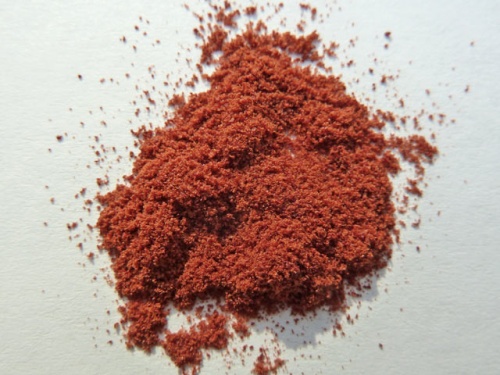

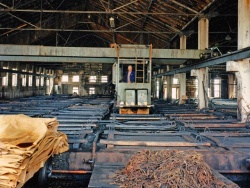

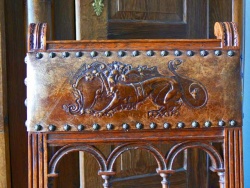



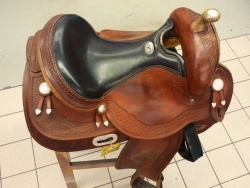
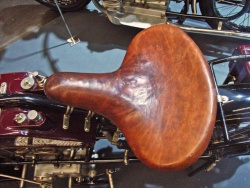
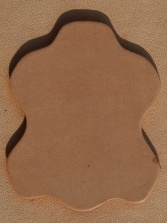
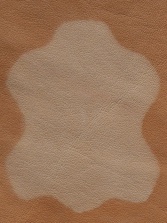
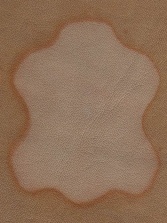

 a kotori web solution
a kotori web solution